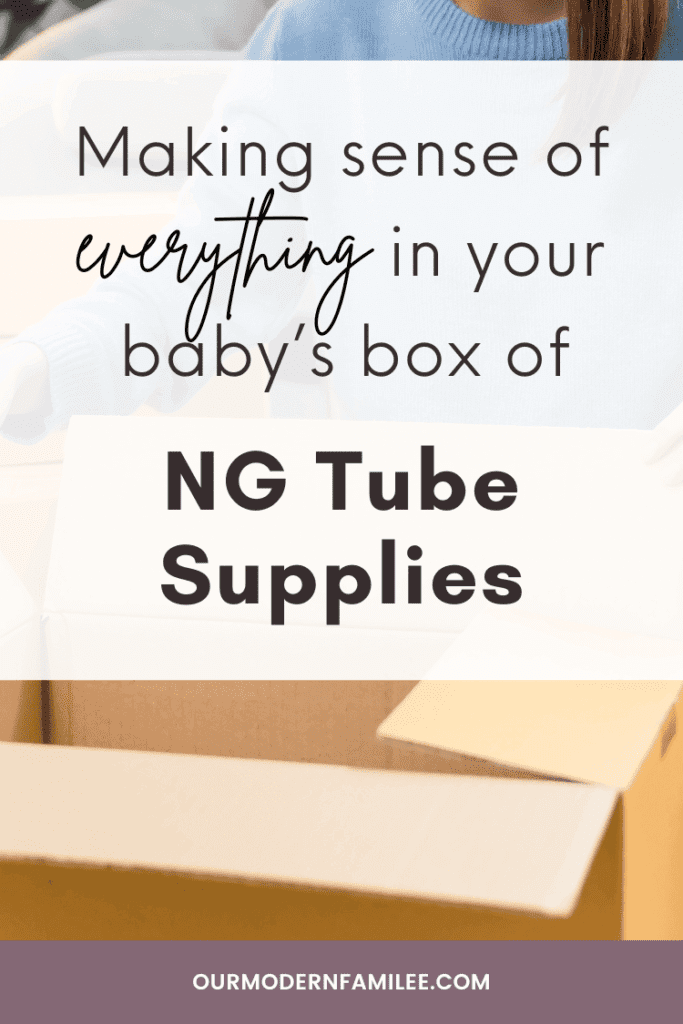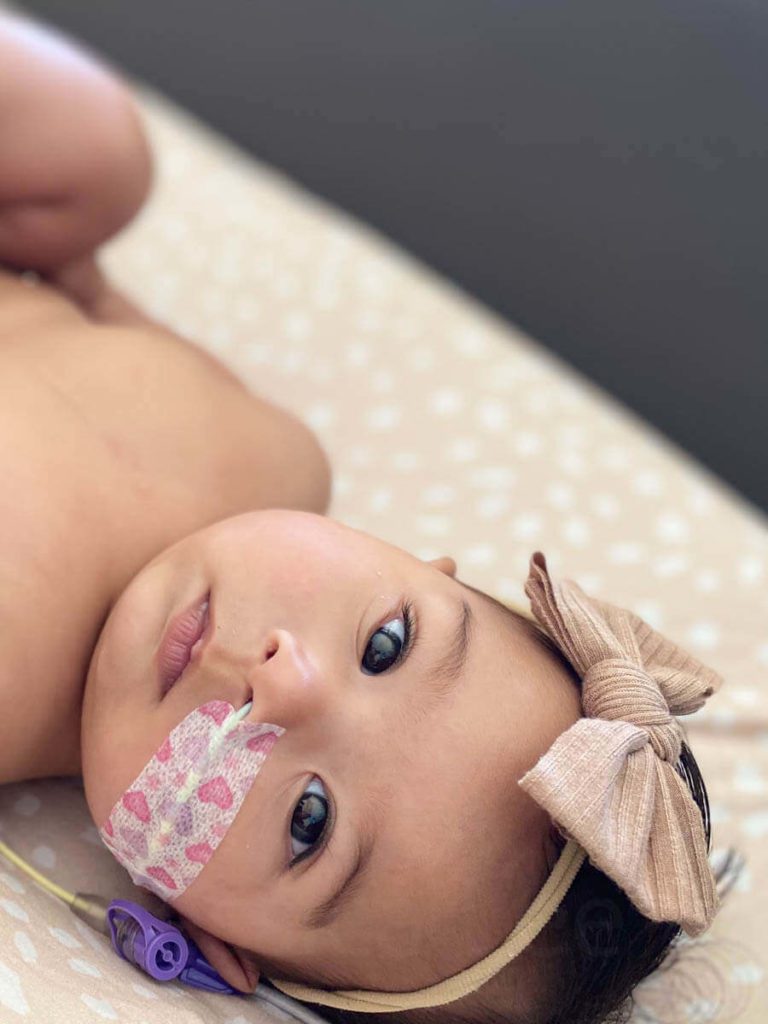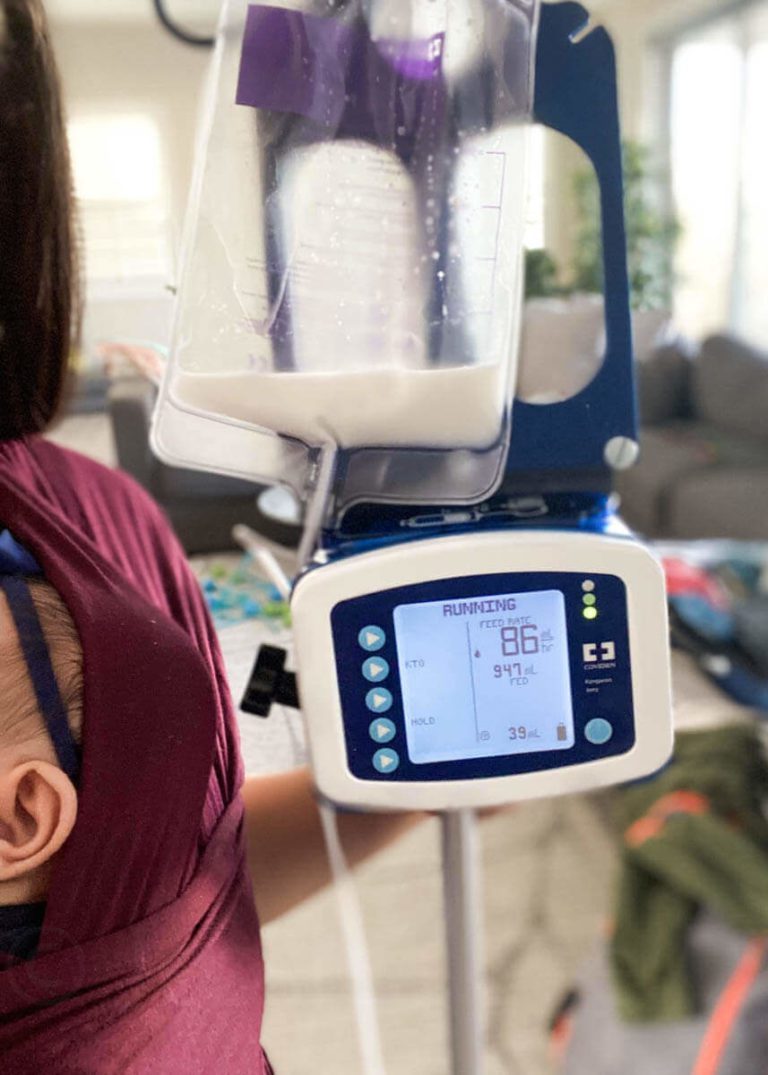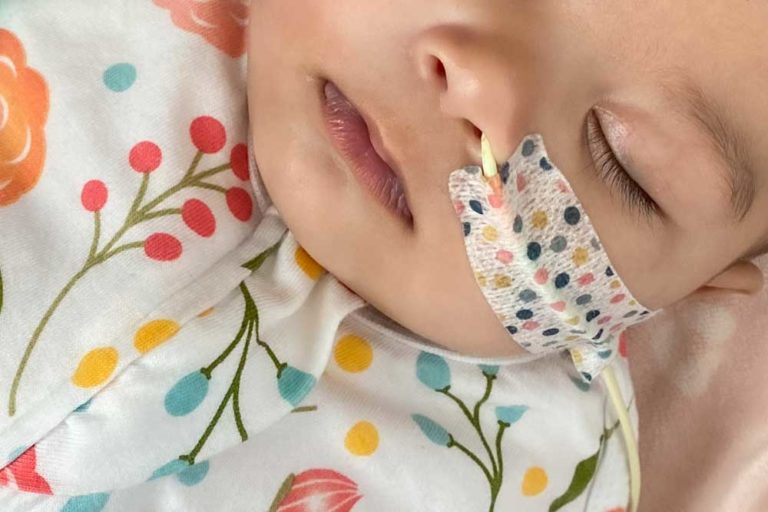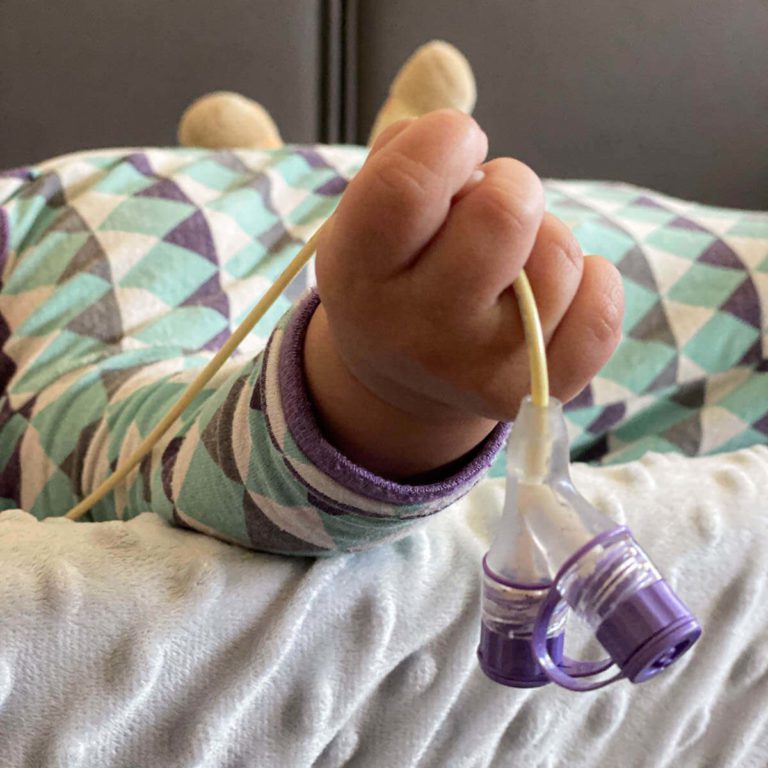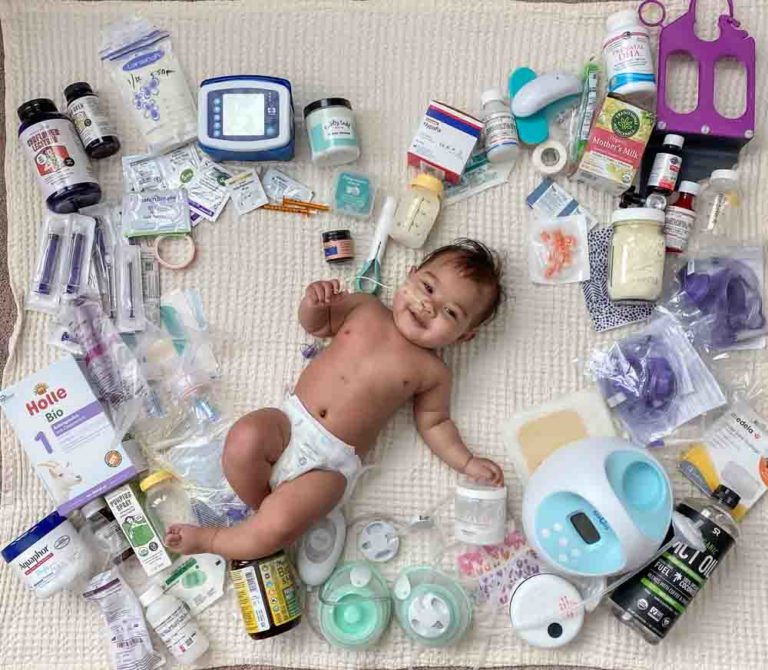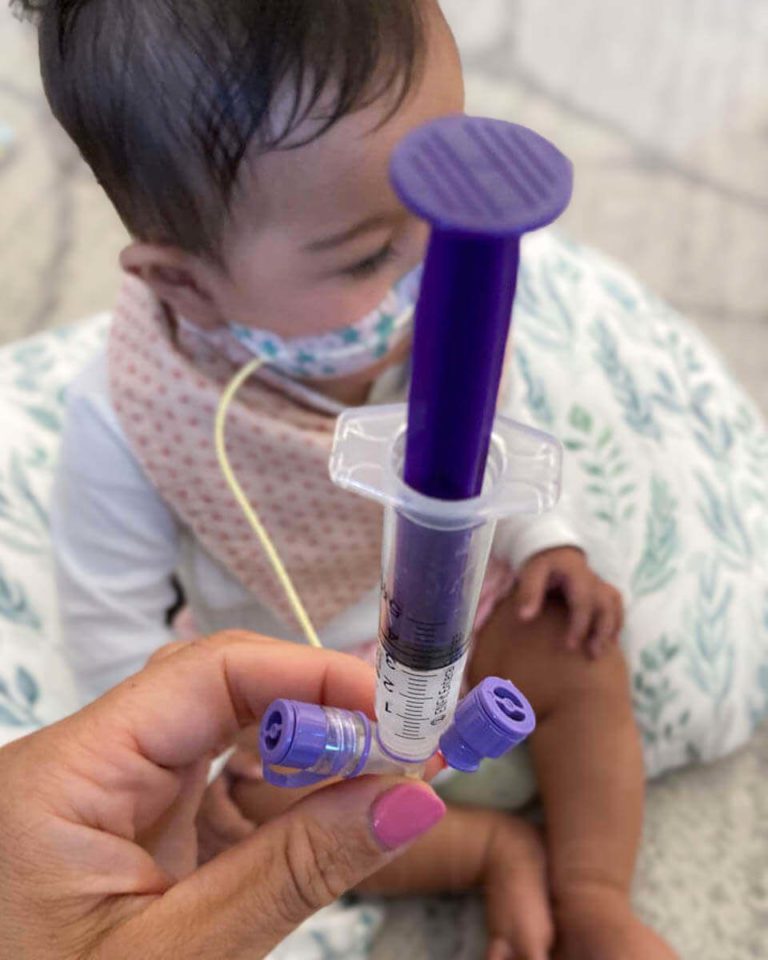Unboxing and Understanding Your Baby’s NG Feeding Tube Supplies
My jaw dropped the first time I saw the feeding tube supplies delivered to my front door. And then I learned it was only box 1 of 2. Tube feeding at home is a great option that allows more people to live their lives more fully and freely. For those who are unable to eat or receive their necessary medications or nutrition in a typical manner, feeding tubes throw them a buoy. Scratch that, a lifeboat. One packed with a lot of supplies.
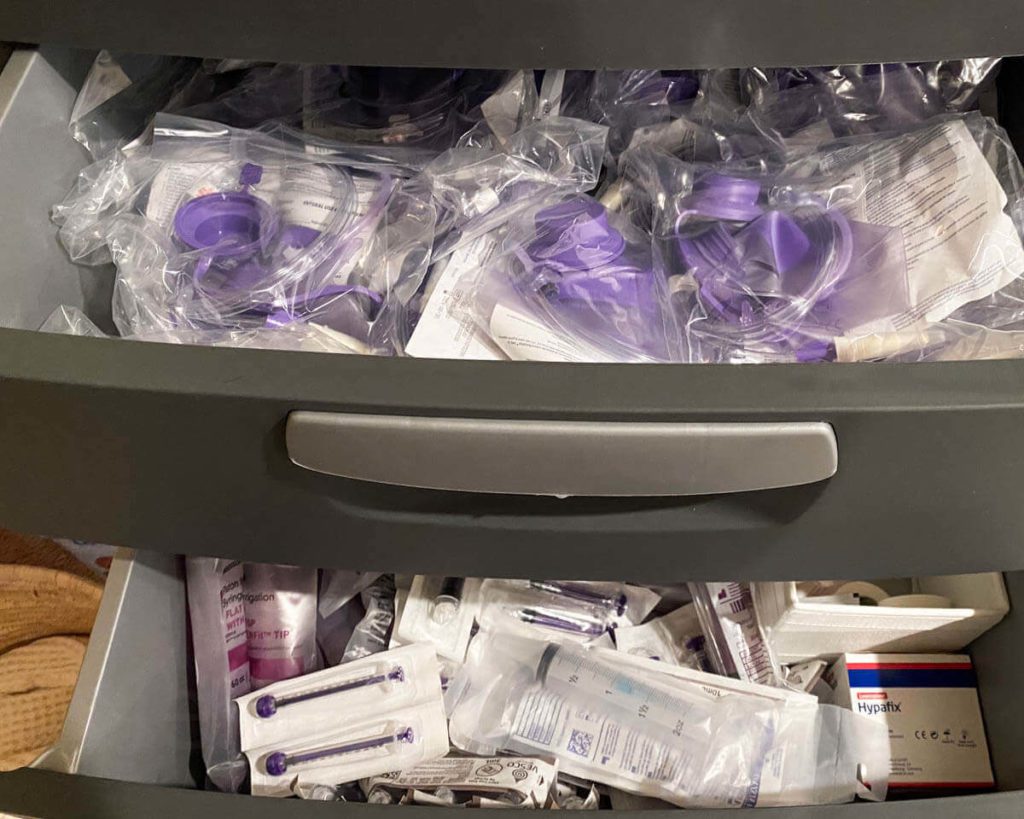
Why we needed supplies
Shortly after birth, my daughter got her first nasogastric tube. She stayed in the hospital for her first month recovering from open-heart surgery due to critical congenital heart defects. By discharge, she was still unable to swallow safely or gain weight effectively so the feeding tube came home with us.
We were able to leave the hospital and bring her home with us, thankfully, but she was in a fragile state called interstage awaiting a second open-heart surgery. Weight gain was a key factor in getting to this second surgery. Her NG tube was her lifeline.
For eight long months, I managed my heart warrior’s NG tube feeding at home and everything that came along with that. Supplies, lots of supplies, came along with it.
At first, I took whatever they gave me. Over time though, I gained a better understanding of what everything was inside the boxes, what was better for my daughter, and what my preferences were as her caregiver. I learned I could request additional items and declined others we weren’t using.
In the hospital, we were provided her feeding tube pump, pole, and clamp. At home, in monthly DME (durable medical equipment) shipments, we received a backpack, NG tubes, lubricant packets, wipes, dressings, tapes, syringes, and bags.
If you have a new NG tubie baby, all the supplies can seem overwhelming. Let’s go over some frequently asked questions about NG supplies and unbox a shipment together to understand all the items.
NOTE: This is written from the perspective and experience within the United States healthcare system. Supplies, details, and processes may vary elsewhere.
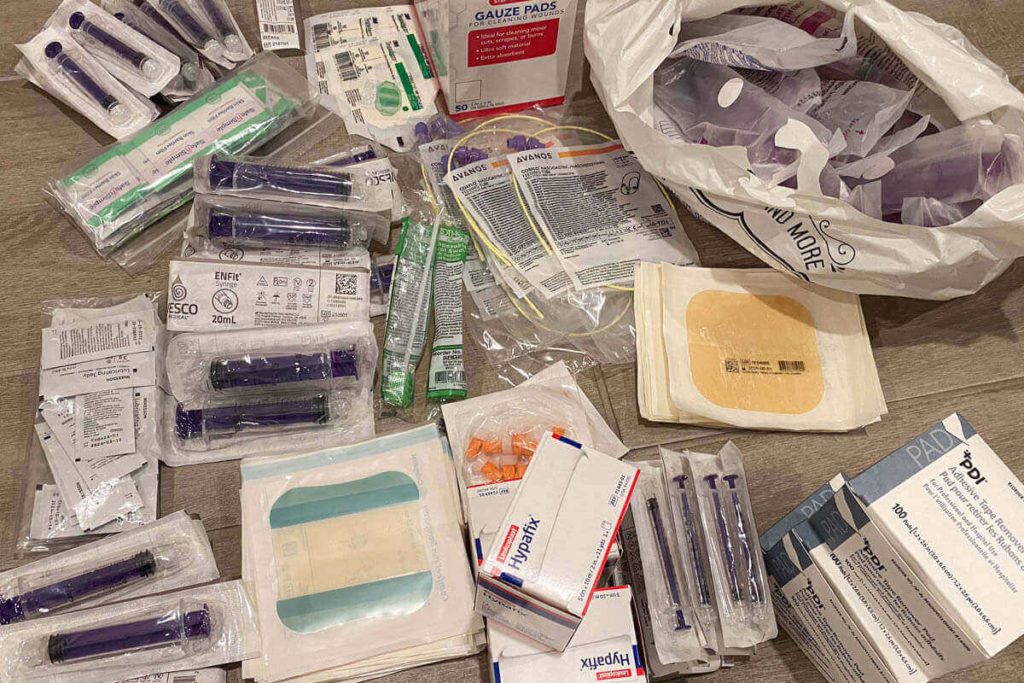
FAQs about Tube Supplies
Where to buy feeding tube supplies?
Feeding tube supplies should be provided to the patient as necessary medical equipment, just as other prescribed essential medications. If you’re unable to get everything you need or want, you can ask or you can buy extra supplies from other tubie parents, on Amazon, or other pharmacy and medical supply stores.
Where do you get your baby’s NG supplies?
Typically your baby will first get their NG tube in the hospital. There they should set you up with a feeding pump and a small amount of essential supplies to get you started at home. Shortly, you should receive a shipment directly to your home from your DME (durable medical equipment) of more supplies.
Do you have to pay for them?
No, you should not need to pay for your child’s NG supplies as they are a medical necessity. They should be covered through your health insurance. If there are specialty items or if you have different supply preferences your DME is unable to provide, then you can consider purchasing your own items.
How do you get refills?
A representative should tell you who to contact when you need your supplies re-filled. If it’s not clear, ask! Some DMEs may provide your supplies automatically, typically monthly. However, others require you to call to confirm the order.
Ours waited for me to call, or if I didn’t then they would call me to ask and confirm. I was worried about this being another thing on my to-do list. But I liked this process as this is how I could regularly tinker with our order and get different supplies rather than what they thought we would need.
How frequently do you receive tube supplies?
Your supply refill schedule will depend on your child’s specific needs, tube frequency use, and insurance. In my experience, ours were refilled once a month.
What if you need something else?
You can always ask the DME to provide different and additional feeding supplies. They may say yes, or they may say no. If it’s something you feel is really necessary, but they say no. Then go to your child’s doctor and ask if they can prescribe it so your DME can provide it.
If you want something else that isn’t considered essential or is not offered through DME, then you likely will need to purchase it yourself.
What happens if you need to travel?
If you need to travel with your tub-fed child and all their supplies, request a DME shipment to your destination instead of home to make packing easier. For my daughter’s second open-heart surgery, we had to travel to Boston. We would be there awhile, so it was helpful to have our DME send supplies to our accommodations rather than lug everything through the airport ourselves.
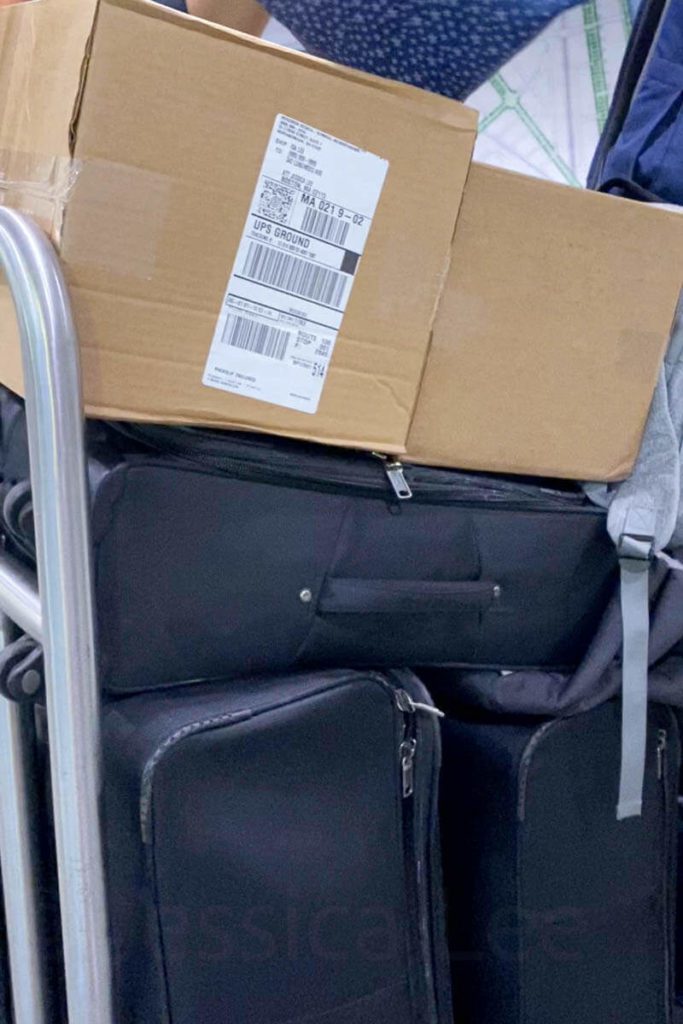
Opening your box of feeding tube supplies
The following items will not automatically be provided to everyone. Your home tube feeding supplies will vary based on your child’s diagnosis and condition, doctor’s script, insurance, and your DME.
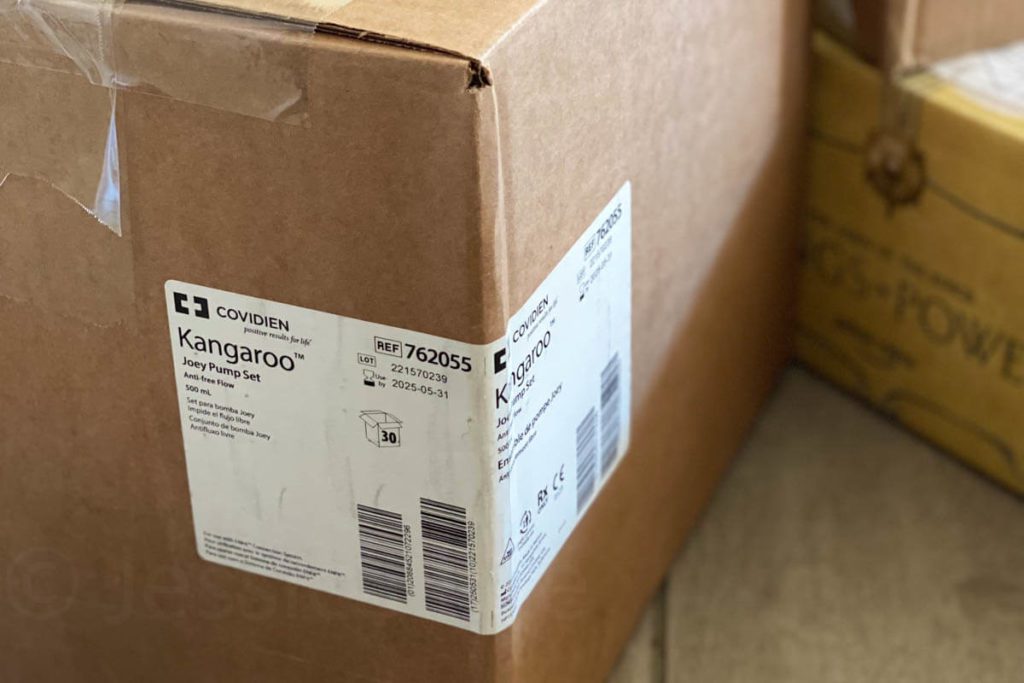
Affiliate Disclosure: As an affiliate, and a member of the Amazon Services LLC Associates Program, we may earn commissions from qualifying purchases at no additional cost to you.
Pump
A feeding pump is a small portable machine for enteral feeding. You snake a feeding bag’s tubing through the machine and connect that to the patient’s feeding tube. This allows medication and milk to be pushed through the tube automatically at whatever rate you set it to.
The Infinity pump or a Kangaroo Joey pump are often provided for nasogastric tube feeding at home. Typically, your insurance pays to rent the pump, and you return it when it’s no longer needed.
Pole
An IV pole is provided to allow you to hang up the feeding pump and feeding bags or syringes. It’s supposed to assist in feeding, however, it can be a tripping hazard and some parents find it more hurtful than helpful. We still used the pole in certain situations, like for night feeds, but while moving around during the day the pole was often a nuisance.
Clamp
You should receive a metal clamp that enables you to attach the feeding pump to the IV pole. These are unique to whichever feeding pump you are provided.
Backpack
Some DMEs can give you a feeding pump backpack for greater portability. These backpacks are tailor-made to their specific feeding pump with special straps, pockets, and holes for the feeding pump and tubing. This enables you to move around more easily, get out of the house, and have your child eat on the go.
NG Tube
If you were trained to replace your baby’s NG tube at home, then your supplies should include replacement tubes. If you have it replaced at the hospital, then they will carry the appropriate supplies and you will not receive this in your box.
PLEASE NOTE: Only attempt to insert an NG tube if you have been directed to and received proper training by your child’s medical team. Improper insertion can cause injury and damage.
Lubricant
Water-based lubricant jelly is often recommended and provided to help with tube insertion. DMEs usually give you small one-use packets.
Wipes
NG tube management involves frequently removing and adhering tape to your baby’s cheek. To help with this, you should get adhesive remover wipes to aid in removing the tape more easily. These wipes help lift the tape and remove any adhesive residue from the skin.
You should also receive skin barrier wipes, or another format (paste or swab), which should help protect the baby’s cheek. These wipes add a layer of protection to the cheek to minimize irritation from the tube and tape.
Dressing
To further help your tubie’s cheeks, it’s common to use a barrier dressing. This goes on the cheek first underneath the tube, then a tape goes on top securing the tube. Two popular dressings are Comfeel Plus and DuoDERM which are kind of like a thin pad with adhesive on one side.
Tape
There are so many different kinds of medical tape, but not everything works for NG tubes. Babies’ faces are sensitive, putting tape on, and regularly taking it off can further irritate their cheeks. Finding the right tape for your baby is important.
In our box, we received Micropore tape, Tegaderm, and Hypafix. Micropore we used for one-off gauze taping needs, but not regularly for daily NG use. Tegaderm is a popular NG tape to use. It’s very thin, transparent, breathable and hypoallergenic, but I find it difficult to get flat. Hypafix is flexible, hypoallergenic, white and works well for sensitive skin.
Syringes
Feeding tube syringes should be included in your box. These syringes do not have any needles! They are designed specifically for enteral feeding purposes and are meant for medications and other liquids, to allow you to push medications for your baby through their NG tube. You can also use the larger syringes for gravity feeds if preferred.
The syringes come in a range of sizes, such as 1mL, 5mL, 10mL, 20mL, and 60mL. There are slip-tip syringes, and also ones that screw onto a tube’s port (e.g., Luer Lock, ENFit®).
Bags
You should receive feeding tube bags to use along with their feeding pump. These are plastic disposable bags and the look will vary slightly based on whichever pump brand you are using. They have a large colored cap (ours were purple, others are teal) to open and fill up the bag with milk or formula and close it.
Long tubing is attached to the bag that you thread through the feeding pump and attach to the NG tube port. The milk travels from the feeding bag through the bag’s tubing, pushed by the feeding pump, through the NG tube, and into the stomach. Most feeding bags are meant to be switched out for a new one every 24 hours.
Formula
If your baby requires a special high-calorie or other medically necessary formula, this may be possible to fulfill through your DME.
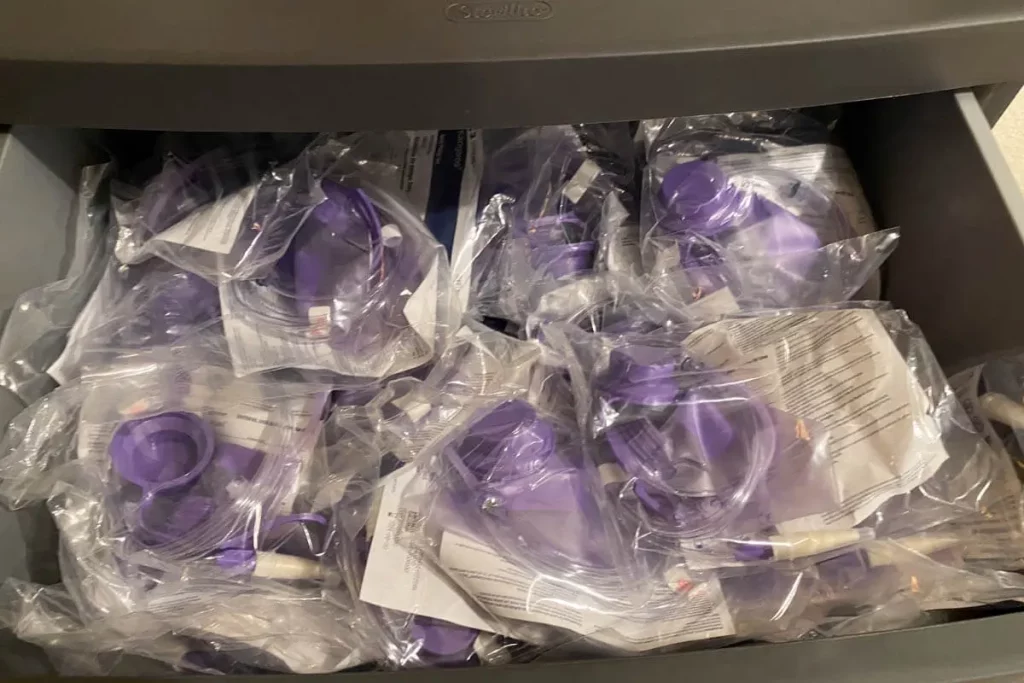
Other Accessories, Medications and Supplies
If there are further accessories you want to use for your tubie baby, you will need to look into purchasing these yourself. There are cute feeding tube tape, pump hangers, pump holders, syringe holders, and adorable tubie backpacks.
For your child’s medications, you will need to process these as you do any other medication. You will get them from a pharmacy, they will not come with your tube supplies.
If your DME is unable to provide you with certain supplies, sometimes you can find other tube-feeding families who are willing to give away or sell their extra supplies (in Facebook tubie support groups). Otherwise, you can purchase additional supplies on Amazon or at pharmacies and medical supply stores.
Packing it up
There are numerous supplies necessary when using a feeding tube. Fear not, you are not responsible for buying everything. Babies feeding with an NG tube have a medical reason for the tube. This means it is medically necessary, and therefore, the essential supplies should be covered by insurance.
The NG supplies are fulfilled through a DME. Typically you will be provided a feeding pump, pole, clamp, backpack, NG tube, lubricant, wipes, dressing, tape, syringes, bags, and sometimes formula. It can be so much to take in at first, so I hope this helped clarify the supplies you may unbox. Save this post, pin it, so you can refer back to it when necessary.
Pin it to save it!
